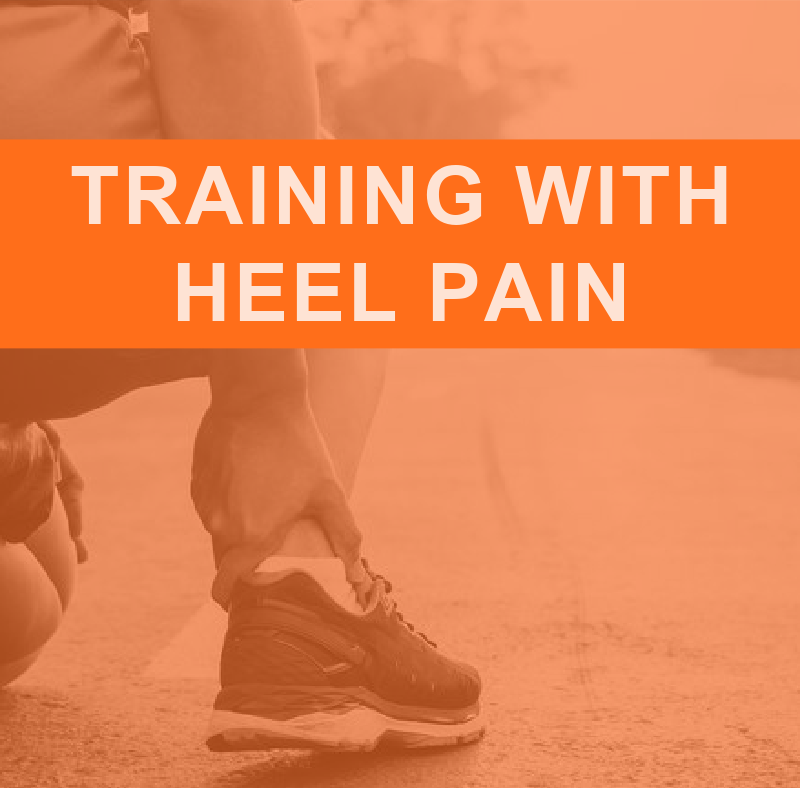
It is not uncommon for clients to come to us with pre-existing injuries, or to experience pain or discomfort at some point. Generally speaking, injuries will require time to rest and recover, but this doesn’t always mean taking a break from training entirely. In the case of plantar fasciopathy, a common injury affecting 1 in 10 people in their lifetime, there are still many ways to continue training through the heel pain and maintain fitness while recovering.
While it is not our job to diagnose or treat, it is within our scope of practice to provide encouragement and support for our clients as they recover.
The Injury: Plantar Fasciopathy
Heel and foot pain affects individuals of all ages and fitness levels. The umbrella term for this injury is plantar fasciopathy, though most clients will be more familiar with plantar fasciitis. Plantar fasciitis involves inflammation of the plantar fascia and it commonly causes a stabbing pain, usually when taking the first steps upon waking. If left untreated, the injury can become chronic and lead to degeneration of the plantar fascia, plantar fasciosis.
No matter what we call it, this injury is painful and it may be challenging to get motivated to exercise.
For clients dealing with plantar fasciopathy, we may be able to provide guidance and targeted exercises for relieving pain. But aside from these injury-specific exercises, what sort of training is appropriate and beneficial to maintain fitness while recovering?
Training through Heel Pain: Cardio
For clients who love to get their heart rate up with sprints and plyometrics, a plantar fasciopathy diagnosis could be especially frustrating. It’s possible that the injury was sustained because of this exercise- it affects 8% of running-based athletes- but, regardless, it is likely to exacerbate the pain and prolong recovery.
Fortunately, there are many options to get a client’s heart rate up without repetitive strain and impact on the inflamed or degenerated plantar fascia.
- Hand Cycle
The hand cycle puts no impact on the feet, and can still get the heart rate up by working the muscles of the upper body. This could be a great option in cases of plantar fasciitis where there is active inflammation. - Stationary Cycle
Because this doesn’t put full body weight on the feet, riding a stationary bike is a great option for cardio and leg strengthening while recovering from plantar fasciopathy. - Rowing
Actual rowing in a boat or kayaking is an option if it’s available where you live, but most gyms will have rowing machines that are a great, easy-on-the-feet way to work out with plantar pain. - Elliptical
While the elliptical is a lower-impact alternative to running on the treadmill, it may still cause foot or heel pain. This could be the last step to check in before returning to running or after pain has subsided.
Training through Heel Pain: Strength Training
For someone who has been incorporating strength training into their workouts, the solution may seem obvious to avoid heel pain: only work the upper body. While it’s true that upper body strengthening exercises remain an option while recovering from plantar fasciopathy, it does not mean lower body exercises should be avoided. In fact, high load strength training can lead to a quicker reduction in pain and improvement in function.
Seated machines are a great place to start as they take the load off of the feet, but slowly and progressively adding load to the plantar fascia can improve tissue capacity.
- Leg Curl
It can be helpful to work the hamstrings as they share a fascial connection with the plantar surface of the foot. Using a leg curl machine can help strengthen the hamstrings without weight bearing on the feet. - Leg Extension
Much like the leg curl, leg extensions are a great exercise to incorporate early in the recovery process since it can keep your clients off of their feet. - Hip Abduction/Adduction
Since the hip muscles play an important role in the biomechanics of the lower limbs, hip strengthening exercises should be incorporated. Specifically, weakness in the hip abductor muscles can contribute to heel pain so strengthening these muscles can optimize management of plantar fasciopathy. - Calf Raises
Eccentric calf raises can improve the outcome of treating plantar fasciopathy and thus can be included in strength training. A slow progression is key here and studies suggest progressing every second week.
Managing an injury can be challenging, but maintaining fitness will ensure our clients can stay on track with their goals and remind them that, with the right mindset, nothing is a setback.
References:
Rathleff, M. S., Molgaard, C. M., Fredberg, U., Kaalund, S., Andersen, K. B., Jensen, T. T., . . . Olesen, J. L. (2015). High-load strength training improves outcome in patients with plantar fasciitis: A randomized controlled trial with 12-month follow-up.(Report). 25(3), e292.
Taunton, J. E., Ryan, M. B., Clement, D. B., McKenzie, D. C., Lloyd-Smith, D. R., & Zumbo, B. D. (2002). A retrospective case-control analysis of 2002 running injuries. British Journal of Sports Medicine, 36(2), 95. doi:10.1136/bjsm.36.2.95
Huffer D, Hing W, Newton R, Clair M. Strength training for plantar fasciitis and the intrinsic foot musculature: A systematic review. Phys Ther Sport. 2017 Mar;24:44-52. doi: 10.1016/j.ptsp.2016.08.008. Epub 2016 Aug 18. PMID: 27692740.
Monteagudo M, de Albornoz PM, Gutierrez B, Tabuenca J, Álvarez I. “Plantar fasciopathy: A current concepts review.” EFORT Open Rev. 2018; 3(8): 485–493. Published 2018 Aug 29.doi:10.1302/2058-5241.3.170080;
Lee, J. H., Park, J. H., & Jang, W. Y. (2019). The effects of hip strengthening exercises in a patient with plantar fasciitis: A case report. Medicine, 98(26), e16258. https://doi.org/10.1097/MD.0000000000016258





